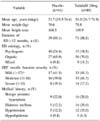1. Mc Kinlay JB. The worldwide prevalence and epidemiology of erectile dysfunction. Int J Impot Res. 2000. 12:S6–S11.
2. Feldman HA, Goldstein I, Hatzichristou DG, Krane RJ, McKinlay JB. Impotence and its medical and psychosocial correlates: results of the Massachusetts Male Aging Study. J Urol. 1994. 151:54–61.
3. Benet AE, Melman A. The epidemiology of erectile dysfunction. Urol Clin North Am. 1995. 22:699–709.
4. NIH Consensus Conference. NIH consensus development panel on impotence. JAMA. 1993. 270:83–90.
5. Rosen RC. Quality of life assessment in sexual dysfunction trials. Int J Impot Res. 1998. 10:Suppl 2. S21–S23.
6. Meuleman EJ, Lycklama A, Nijeholt G, Slob K, Roeleveld X, Damen L, deBrazao GC, et al. Effects of IC351 on erectile response to visual stimulation. J Urol. 1999. 161:Suppl. 212.
7. Juilfs DM, Soderling S, Burns F, Beavo JA. Cyclic GMP as substrate and regulator of cyclic nucleotide phosphodiesterases (PDEs). Rev Physiol Biochem Pharmacol. 1999. 135:67–104.
8. Porst H, Padma-Nathan H, Giuliano F, Anglin G, Varanese L, Rosen R. Efficacy of tadalafil for the treatment of erectile dysfunction at 24 and 36 hours after dosing: a randomized controlled trial. Urology. 2003. 62:121–126.
9. Carson CC, Rajfer J, Eardley I, Carrier S, Dennes JS, Walkers DJ, et al. The efficacy and safety of tadalafil: an update. BJU Int. 2004. 93:1276–1281.
10. Rosen RC, Riley A, Wagner G, Osterloh IH, Kirkpatrick J, Mishra A. The International Index of Erectile Function (IIEF): a multidimensional scale for assessment of erectile dysfunction. Urology. 1997. 49:822–830.
11. Cappelleri JC, Siegel RL, Osterloh IH, Rosen RC. Relationship between patient self-assessment of erectile function and the erectile function domain of the international index of erectile function. Urology. 2000. 56:477–481.
12. Leung KF, Giroudet C. Cross-cultural adaptation of the International Index of Erectile Function (IIEF). Int J Impot Res. 1997. 9:Suppl 1. S47.
13. Brock GB, McMahon CG, Chen KK, Costigan T, Shen W, Watkins V, et al. Efficacy and safety of tadalafil for the treatment of erectile dysfunction: results of integrated analysis. J Urol. 2002. 168:1332–1336.
14. Chen KK, Jiann BP, Lin JS, Lee SS, Huang ST, Wang CJ, et al. Efficacy and safety of on-demand oral tadalafil in the treatment of men with erectile dysfunction in Taiwan: A randomized, double-blind, parallel, placebo-controlled clinical study. J Sex Med. 2004. 1:197–204.
15. Chen KK, Hsieh JT, Huang ST, Jiaan DB, Lin JS, Wang CJ. ASSESS 3: a randomized, double-blind, flexible dose clinical trial of the efficacy and safety of oral sildenafil in the treatment of men with erectile dysfunction in Taiwan. Rev Physiol Biochem Pharmacol. 2001. 13:221–229.
16. Goldstein I, Lue TF, Padma-Nathan H, Rosen RC, Steers WD, Wicker PA. Oral sildenafil in the treatment of erectile dysfunction. N Engl J Med. 1998. 338:1397–1404.
17. Choi HK, Ahn TY, Kim JJ, Kim SC, Paick JS, Suh JK, et al. A double-blind, randomised-placebo, controlled, parallel group, multicentre, flexible-dose escalation study to assess the efficacy and safety of sildenafil administered as required to male outpatients with erectile dysfunction in Korea. Int J Impot Res. 2003. 15:80–86.
18. Sunwoo S, Kim YS, Cho BL, Cheon KS, Seo HG, Rho MK, et al. Post-marketing surveillance study of the safety and efficacy of sildenafil prescribed in primary care to erectile dysfunction patients. Int J Impot Res. 2005. 17:71–75.






 PDF
PDF ePub
ePub Citation
Citation Print
Print





 XML Download
XML Download